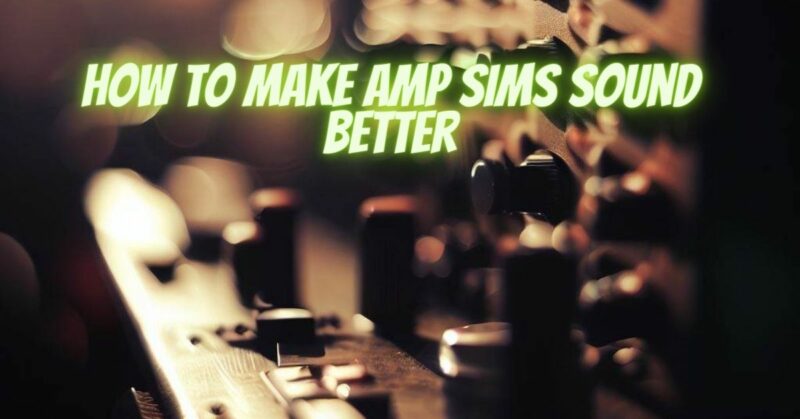Amp simulators have revolutionized the way musicians and producers create and manipulate guitar and instrument tones. While amp sims offer incredible versatility and convenience, there are strategies to make them sound even better and more authentic. In this article, we’ll explore effective techniques for enhancing the quality of your amp simulations and achieving professional-grade results.
1. Select the Right Amp Model
The first step to improving your amp simulation sound is selecting the right amp model. Experiment with different amp models to find the one that best suits the genre and style of music you’re working on. Pay attention to factors like tonal character, distortion types, and dynamic response.
2. Tweak the EQ Settings
Fine-tuning the EQ settings can significantly impact the tone of your amp simulation. Focus on adjusting the bass, midrange, and treble frequencies to achieve the desired balance. Consider the role of the instrument in the mix and tailor the EQ accordingly.
3. Experiment with Mic Placement
Most amp simulators allow you to simulate microphone placement on a virtual cabinet. Experiment with different mic positions to find the one that captures the desired level of warmth, presence, and detail in your sound. Just as in real-world recording, mic placement plays a crucial role in shaping the tone.
4. Layer Amps and Effects
To create a richer and more complex sound, consider layering multiple amp simulations and effects. This can involve using different amp models for different frequency ranges or adding effects like chorus, delay, or reverb to enhance the spatial and textural qualities of the sound.
5. Pay Attention to Dynamics
One of the challenges with amp sims is replicating the dynamics of a real amplifier. Work on your playing technique to bring out varying levels of intensity. Additionally, explore amp sim settings that allow you to adjust the sensitivity of the simulation to your playing dynamics.
6. Utilize Impulse Responses (IRs)
Impulse responses are digital snapshots of real-world cabinets and microphones. Many amp simulators allow you to load custom IRs, enabling you to experiment with various cabinet and microphone combinations for a more authentic sound.
7. Address Phase Issues
When using multiple amp simulations and effects, be mindful of potential phase issues that can arise. Use your ears and phase correction tools to ensure that the combined sound remains coherent and doesn’t lose depth or clarity.
8. Embrace Automation
Automation is a powerful tool for enhancing the expressiveness of your amp simulations. Automate parameters like gain, volume, and effects settings to create dynamic shifts and textures within your performance.
9. Focus on Signal Chain Order
The order in which you place effects within your signal chain can have a significant impact on the overall sound. Experiment with different orders to achieve the best sonic results. For example, placing a distortion effect before the amp simulation can yield different outcomes compared to placing it after.
10. Reference Real Amps
Listening to recordings of real amplifiers in a similar musical context can provide valuable insights into the nuances of their sound. Use these references as benchmarks to fine-tune your amp simulations and make them more authentic.
Amp simulators offer a world of sonic possibilities, and with careful attention to detail and experimentation, you can enhance their quality to match or even surpass the tones of physical amplifiers. By choosing the right amp models, crafting a balanced EQ, exploring mic placement, layering effects, and considering the dynamics, you’ll transform your amp simulations into powerful tools that elevate your music production and performances to new heights. Remember that each step you take in refining your amp simulations contributes to your unique sound signature, allowing you to create music that resonates with your artistic vision.


